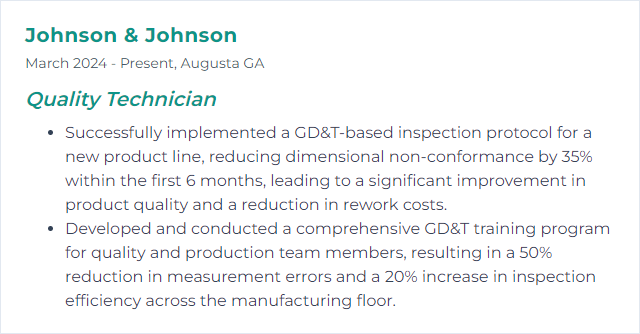Top 12 Quality Technician Skills to Put on Your Resume
In today's competitive job market, a quality technician needs more than checklists and clipboards. You need sharp, demonstrable skills that speak to consistency, rigor, and a nose for problems before they bloom. Below, you’ll find twelve core capabilities worth elevating on your resume—and backing up with results—so hiring managers don’t hesitate.
Quality Technician Skills
- ISO 9001
- Six Sigma
- Lean Manufacturing
- Statistical Process Control (SPC)
- Quality Management Systems (QMS)
- Root Cause Analysis
- Continuous Improvement
- Auditing Techniques
- Calibration
- Metrology
- Minitab
- Geometric Dimensioning and Tolerancing (GD&T)
1. ISO 9001
ISO 9001 defines the requirements for a quality management system. It anchors consistency, risk-based thinking, and customer focus. For a Quality Technician, it translates into disciplined processes, documented control, and measurable improvement.
Why It's Important
It standardizes how quality is planned, executed, and verified, ensuring products meet requirements while fueling continuous improvement and customer satisfaction.
How to Improve ISO 9001 Skills
Audit routinely: Plan internal audits, track nonconformities, and verify effectiveness of corrective actions.
Sharpen documentation: Keep procedures lean, current, and easy to follow. Out-of-date documents breed defects.
Correct at the root: Address causes, not symptoms, and validate fixes with evidence.
Measure what matters: Define clear KPIs, review trends, and adjust controls quickly.
Promote quality culture: Involve operators, supervisors, and leadership so improvement isn’t a side project—it’s the job.
Close the loop with customers: Pull feedback into your QMS and act on it.
How to Display ISO 9001 Skills on Your Resume
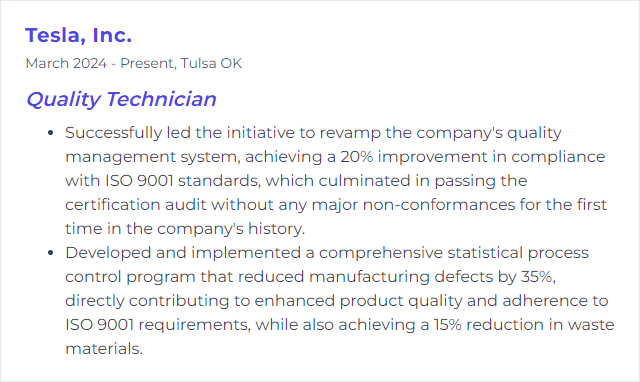
2. Six Sigma
Six Sigma is a data-first approach to reduce defects and variation. Define, measure, analyze, improve, control—the DMAIC backbone guides sound decisions and durable gains.
Why It's Important
It cuts noise from processes, tightens capability, and improves yield. Less scrap, fewer escapes, better cost control.
How to Improve Six Sigma Skills
Deepen statistics: Confidence intervals, hypothesis tests, capability studies, DOE—know when and why to use each.
Blend with Lean: Pair waste reduction with variation reduction for speed and stability.
Certify and apply: Pursue belts and run real projects. Results outrun theory.
Standardize tools: CTQ trees, fishbones, FMEA, control plans—make them routine, not rare.
Use software well: Build clean datasets, validate assumptions, and document analysis trails.
How to Display Six Sigma Skills on Your Resume

3. Lean Manufacturing
Lean focuses on delivering value with less waste—motion, waiting, defects, overproduction, and the rest of the usual suspects. The aim: flow that feels frictionless.
Why It's Important
It boosts throughput, quality, and morale. When processes are clear and uncluttered, defects have nowhere to hide.
How to Improve Lean Manufacturing Skills
Run PDCA often: Small cycles, fast feedback, visible wins.
Use 5S relentlessly: Order, clean, standardize, sustain—so problems stand out.
Map value streams: See the whole, remove bottlenecks, shorten lead time.
Standard work: Lock in best-known methods and make deviations obvious.
Kaizen engagement: Pull ideas from the floor; momentum beats mandates.
Build in quality: Poka‑yoke and visual controls over after-the-fact inspection.
How to Display Lean Manufacturing Skills on Your Resume
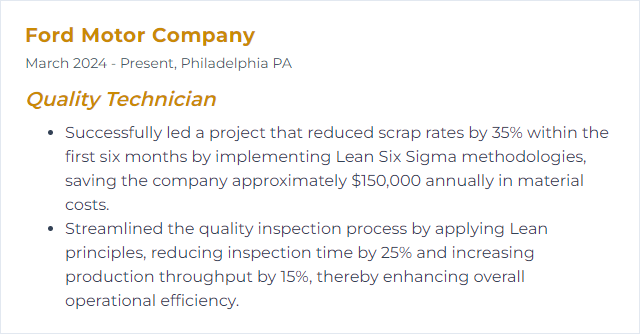
4. Statistical Process Control (SPC)
SPC keeps a pulse on process behavior using control charts and capability metrics, distinguishing common-cause variation from special causes before defects erupt.
Why It's Important
It catches drift early, stabilizes processes, and reduces firefighting. Data over hunches.
How to Improve Statistical Process Control (SPC) Skills
Collect good data: Calibrated gages, clear sampling plans, disciplined entries.
Choose the right charts: X‑bar/R, I‑MR, p, np, c, u—match the chart to the data type and subgrouping.
React with rules: Use standard signals for out-of-control conditions and act quickly.
Tie SPC to process knowledge: Layer in process maps and FMEA to explain signals, not just spot them.
Review capability: Cp, Cpk, Pp, Ppk—understand short-term vs. long-term performance and improve accordingly.
Audit the system: Verify charts are used, limits are valid, and responses are consistent.
How to Display Statistical Process Control (SPC) Skills on Your Resume
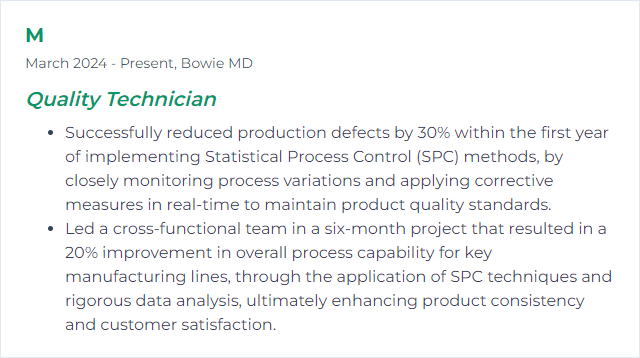
5. Quality Management Systems (QMS)
A QMS is the framework that aligns policy, process, procedure, and records—so quality isn’t accidental, it’s engineered.
Why It's Important
It organizes how work is done, controlled, and improved. Fewer surprises, stronger compliance, predictable results.
How to Improve Quality Management Systems (QMS) Skills
Audit with purpose: Find gaps, fix causes, verify effectiveness, and share lessons.
Embed risk-based thinking: Identify risks and opportunities, plan controls, and monitor outcomes.
Simplify documents: Trim bloat, remove ambiguity, and link procedures to real workflows.
Digitalize wisely: Use QMS tools for change control, training, CAPA, and metrics dashboards.
Integrate feedback: Customer input, supplier scorecards, internal NCRs—feed the system, not the drawer.
Engage leadership: Objectives, resources, and accountability start at the top.
How to Display Quality Management Systems (QMS) Skills on Your Resume

6. Root Cause Analysis
RCA finds the real reason behind a problem—then makes it stay gone. Symptoms whisper; causes matter.
Why It's Important
It prevents recurrence, cuts cost of poor quality, and strengthens processes instead of patching them.
How to Improve Root Cause Analysis Skills
Use the right tools: 5 Whys, fishbone, Pareto, fault trees, 8D—pick tools that fit the problem.
Get the facts: Time-stamped data, photos, samples, operator input—evidence beats speculation.
Look systemic: Process design, training, environment, methods—go beyond the immediate mistake.
Validate causes: Test hypotheses with data or experiments before fixing the wrong thing.
Implement solid actions: Error-proof where possible, standardize, retrain, and update control plans.
Monitor sustainment: Track results after implementation; confirm the fix holds under real conditions.
How to Display Root Cause Analysis Skills on Your Resume
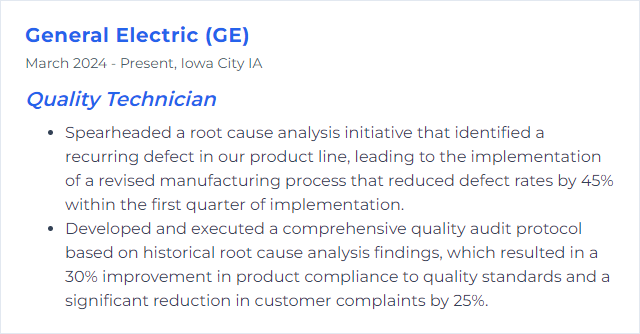
7. Continuous Improvement
Continuous Improvement is the daily habit of making things better—incrementally and, sometimes, dramatically. Process by process, variation by variation.
Why It's Important
It compounds gains: higher quality, lower cost, faster flow. Teams get engaged, customers notice.
How to Improve Continuous Improvement Skills
Set SMART targets: Clear goals focus action and prove value.
Blend Lean and Six Sigma: Remove waste and reduce variation in one-two punches.
Elevate problem-solving: A3 thinking, PDCA, and RCA—teach, practice, repeat.
Use data well: Dashboards, leading indicators, and simple visuals that drive decisions.
Build team rhythms: Daily huddles, gemba walks, and quick experiments to keep momentum.
Standardize wins: Lock in improvements with procedures, training, and controls.
How to Display Continuous Improvement Skills on Your Resume
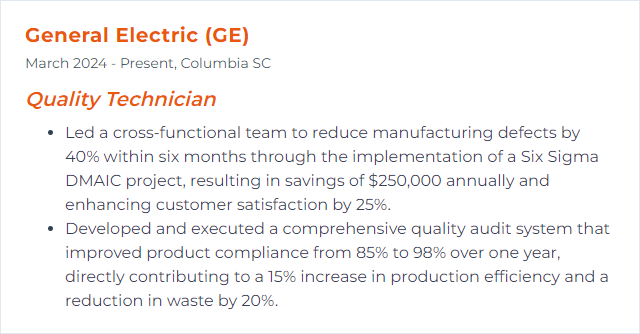
8. Auditing Techniques
Auditing techniques are the methods used to evaluate whether processes match policies, standards, and reality on the floor. Documents tell one story; evidence tells the truth.
Why It's Important
Audits reveal blind spots, verify compliance, and surface improvement opportunities before customers feel the pain.
How to Improve Auditing Techniques Skills
Plan risk-based audits: Prioritize high-impact processes and known problem areas.
Strengthen interviewing: Ask open questions, cross-check, observe work as performed.
Sample smart: Use representative sampling and trace records end-to-end.
Use checklists—lightly: Guide consistency without blinding judgment.
Write crisp findings: Evidence, requirement, gap, and risk—clear and actionable.
Follow through: Verify corrective actions and close the loop with effectiveness checks.
How to Display Auditing Techniques Skills on Your Resume

9. Calibration
Calibration aligns instruments to known standards so measurements are trustworthy. No accuracy, no quality.
Why It's Important
It protects the integrity of every decision built on measured data—accept, reject, adjust, release.
How to Improve Calibration Skills
Know the standards: Follow applicable laboratory and equipment requirements and traceability practices.
Maintain schedules: Risk-based intervals, usage-based triggers, and clear status labeling.
Control environment: Temperature, humidity, vibration—stability matters.
Record meticulously: As-found/as-left data, uncertainty, references used, and technician sign-off.
Verify and cross-check: Use check standards and intercomparisons to spot drift early.
Preventive maintenance: Clean, inspect, and service tools to avoid sneaky errors.
Train regularly: Techniques, uncertainty concepts, and handling practices to reduce measurement error.
How to Display Calibration Skills on Your Resume

10. Metrology
Metrology is the science of measurement—accuracy, precision, traceability, and uncertainty coming together so numbers mean what we think they mean.
Why It's Important
Bad measurements derail good processes. Solid metrology keeps specifications honest and outcomes consistent.
How to Improve Metrology Skills
Calibrate and verify: Set intervals, verify performance, and document uncertainty.
Train on methods: Gage R&R, measurement system analysis, proper fixturing and technique.
Use SPC on measurement: Monitor measurement processes themselves, not just production output.
Adopt modern tools: 3D scanning, CMM strategies, and digital gaging where they add repeatability.
Control conditions: Lighting, surface cleanliness, thermal soak—small factors, big swings.
Collaborate: Work with engineering to align tolerances, datums, and inspection strategies.
How to Display Metrology Skills on Your Resume

11. Minitab
Minitab is a statistics workhorse for quality pros—clean visuals, robust tests, and reliable tools for DOE, capability, and control charts.
Why It's Important
It turns raw data into clear decisions and repeatable improvements. Faster analysis, fewer errors.
How to Improve Minitab Skills
Master the basics: Data types, graphing, summarizing, and simple tests done right.
Level up with DOE: Factorial designs and response optimization to chase breakthroughs.
Practice regularly: Analyze real shop-floor problems and validate findings.
Template your workflows: Standard session commands, macros, and reports for consistency.
Document assumptions: Check normality, independence, and stability before drawing conclusions.
How to Display Minitab Skills on Your Resume
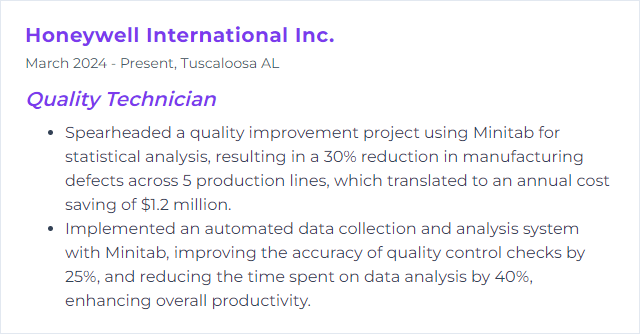
12. Geometric Dimensioning and Tolerancing (GD&T)
GD&T is the language of function and fit. Symbols, datums, and feature control frames specify what truly matters so parts assemble and perform as intended.
Why It's Important
It reduces ambiguity, prevents misinterpretation, and links design intent to inspection reality. Fewer disputes, better parts.
How to Improve Geometric Dimensioning and Tolerancing (GD&T) Skills
Know the standard: Study the governing GD&T standard and stay current with revisions.
Practice on drawings: Interpret real prints, build inspection plans, and reconcile with functional needs.
Use the right tools: Leverage CMM strategies, functional gaging, and proper datum setups.
Close the loop with design: Collaborate on datum schemes, tolerances, and measurement feasibility.
Apply in production: Validate GD&T callouts with actual process capability and adjust where needed.
How to Display Geometric Dimensioning and Tolerancing (GD&T) Skills on Your Resume
